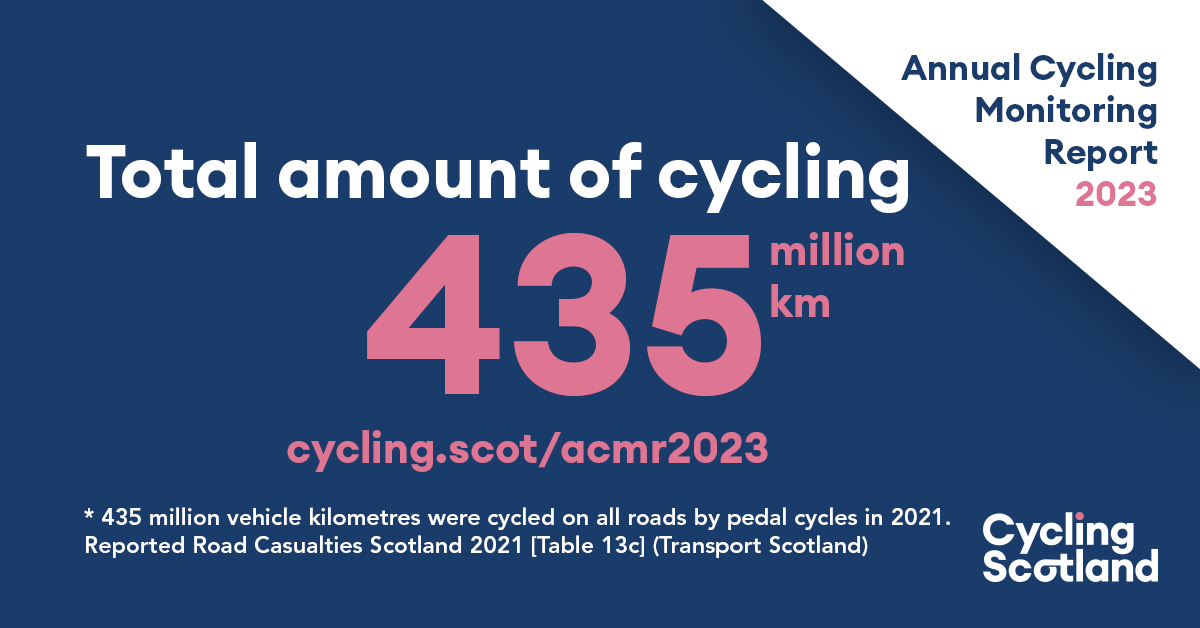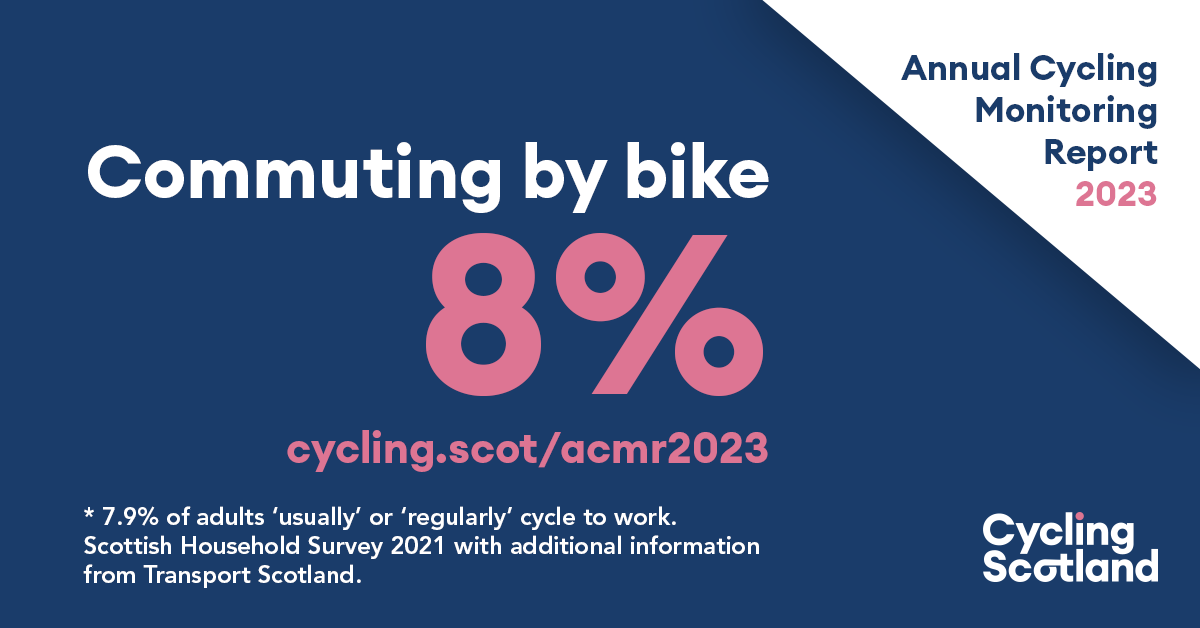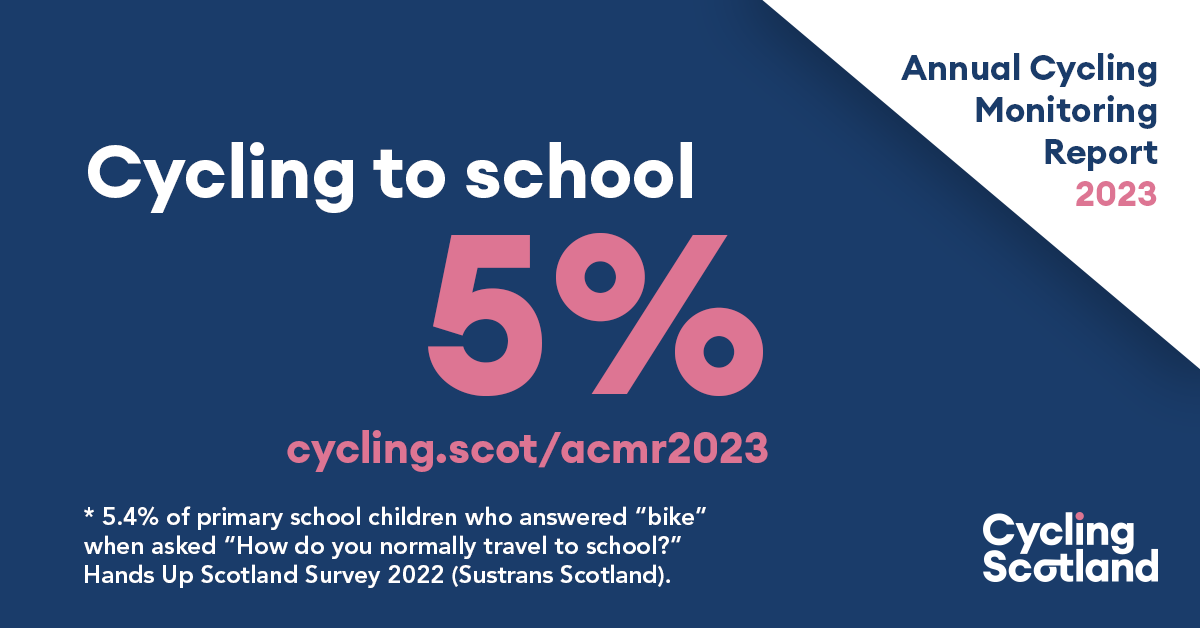Monitoring/Policy
Are we cycling towards a greener, friendlier, and more accessible Scotland?
28 November 2023
The author of this blog is Rowan Simpson, Monitoring & Development Officer.
The Scottish Government’s vision is that people will make walking, wheeling and cycling their most popular choice for short journeys by 2030.
Cycling Scotland’s Annual Cycling Monitoring Report gathers the latest data on everyday cycling in Scotland and provides a snapshot of where we are now and, as we gradually change our travel choices, whether we are on track to achieve this vision.
What does the 2023 Annual Cycling Monitoring Report tell us about everyday cycling in Scotland?
In Scotland, it’s estimated that we cycle 435 million kilometres a year[1]. That’s over 270 million miles. Less than the historic high of 2020, but the equivalent of everyone between the ages of 15 and 64 in Scotland cycling from Edinburgh to Dumfries this afternoon.

The latest figure for adults who usually or regularly travel to work by bike was 7.9% in the 2021 Scottish Household Survey. This is the highest result in the last 12 years. The results from the 2020 and 2021 Scottish Household Surveys cannot be directly compared with previous years (2019 and earlier). This is due to the survey being forced to switch from face-to-face interviews to telephone surveys in response to Covid-19.

Are people changing their travel choices?
Modal share is the share of people using a particular mode of transport (including cycling and walking) within the overall transport usage of a city or region. Tracking modal share can help us understand change because, rather than simply counting the number of people cycling, we are stepping back and looking at the bigger picture. Is there a shift from private vehicles to more sustainable modes of transport? Where does cycling fit in this picture?
The national cycling mode share has hovered around 1.26% between 2012-2019. It’s encouraging to see that the mode share rose to 1.5% in 2020 and 2.3% in 2021. Unfortunately, the survey changes mean we cannot directly compare the recent increased mode share figures with 2019 and earlier.
The next Scottish Household Survey 2022 has returned to a methodology that is similar to the pre-pandemic surveys, and this will be the default going forward. So, keep an eye out for next year’s mode share results which will allow us to make direct comparisons between 2022 data and pre-pandemic figures.
Is it just adults cycling more?
Children are also cycling to primary school more. 5.4% of primary school children travelled to school by bike in 2022, this is the second highest level of the past ten survey years (Sustrans’ Hands Up Scotland Survey). There were no major method changes to this survey during Covid-19, so comparisons are possible.
If we look at the second part of the report that pulls together all the available data for each of Scotland’s 32 local authorities, we can also see the percentage of primary schools delivering Level 2 Bikeability Scotland training. In the 2022-23 session, nine local authority areas delivered on-road cycle training in 100% of primary schools - from Shetland and Orkney in the far north, to the largest authority to date to achieve 100% delivery, the Scottish Borders[2]. Nationally, almost two-thirds (60.3%) of Scottish primary schools participated in Bikeability Scotland on-road cycle training.

Are we moving fast enough?
It's clear that cycling levels are moving in the right direction but progress is slow and there are areas that the report shows are not moving fast enough. Despite an increase during the pandemic, the percentage of households in Scotland that have access to one or more bikes for private use has remained static at around 45% over the last two reporting periods.
The Access to Bikes for Young People Fund is one way that Cycling Scotland is working with partner organisations to increase affordable access to bikes for children and young people, and it will be interesting to see if this investment is reflected in future reporting. The reality is that more needs to be done to ensure that those who wish to cycle are given the opportunity to do so.
Equally, having secure storage for what is, for many, a significant personal investment is another area where change is happening, as we can see from local authority investments in new on-street cycle hangars, but over a third of households in Scotland are likely to have no safe and secure place to store their bikes (Residential Cycle Storage, Cycling Scotland, 2022). This is particularly acute for households living in urban areas, particularly those living in social rented and private rented housing, who are more likely to be living in accommodation where there is nowhere suitable to store a bike.
What happens next?
“To make a difference on the ground, change must be delivered locally.” - Patrick Harvie in the Cycling Framework for Active Travel 2023
The Annual Cycling Monitoring Report is about knowledge. By drawing together information and data from sources both nationally and locally, we are providing a single point of reference to help the sector better understand and more effectively move forward. This collated reporting includes information about financial spending on walking, wheeling and cycling in each local authority (where provided). Whilst not directly comparable across local authority areas, this information will be extremely useful over time as we start to track changes in levels of investment.
If you are interested in tracking the progress of cycling, you might like to:
- Share this report.
- Visit our Cycling Open Data portal. The site hosts real-time hourly data from over 750 fixed cycle counters across all of Scotland’s local authorities. The data is freely available for anyone to access and download.
- Explore urban-specific cycling data in Sustrans’ Walking and Cycling Index which includes 7 Scottish cities.
About the Annual Cycling Monitoring Report
The first report was published in 2015 and the data can be used to measure progress of several indicators established in the Active Travel Outcomes Framework.
The report is split in two; the first section examines cycling metrics at a national scale, and the second section pulls together all the available data for each of Scotland’s 32 local authorities.
Maps and data on the levels of cycling, bike ownership, cycle training and council spending in each of Scotland's 32 local authorities can be viewed from page 20 onwards.
Data is sourced from Scottish Government publications (Scottish Household Survey, Transport and Travel in Scotland, Reported Road Casualties); active travel delivery partner research (Sustrans Scotland, Living Streets Scotland); local authority contributions (active travel expenditure by council area); and from Cycling Scotland’s own programs (cycle counters, traffic surveys, Bikeability Scotland).
Thanks to all contributing partners who enabled us to create as comprehensive picture as possible of cycling in Scotland.
[1] It is estimated that 435 million vehicle kilometres were cycled on all roads by a pedal cycle in 2021 (Reported Road Casualties Scotland 2021)
[2] Aberdeen City, Clackmannanshire, Dundee, East Dunbartonshire, East Lothian, Orkney, Scottish Borders, Shetland & Western Isles delivered Bikeability Scotland on-road cycle training to 100% of primary schools in 2022-2023.
